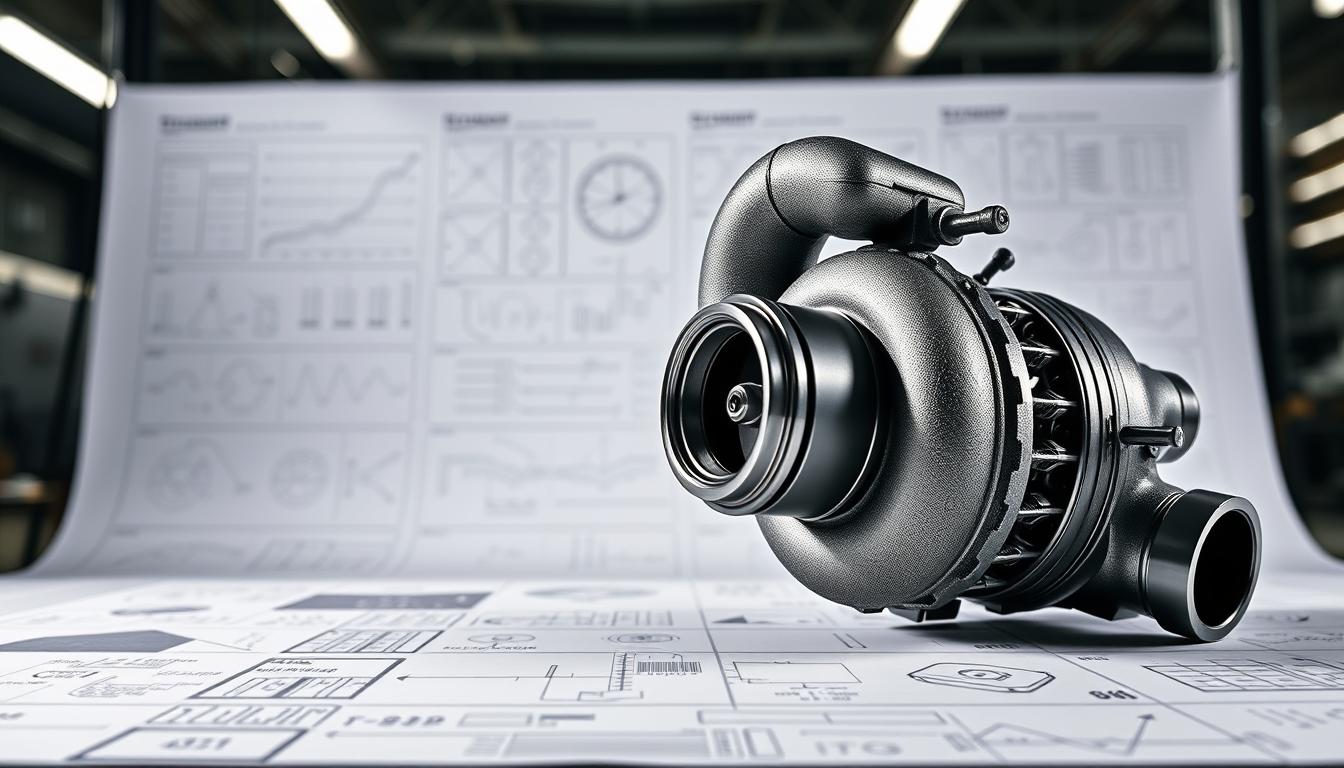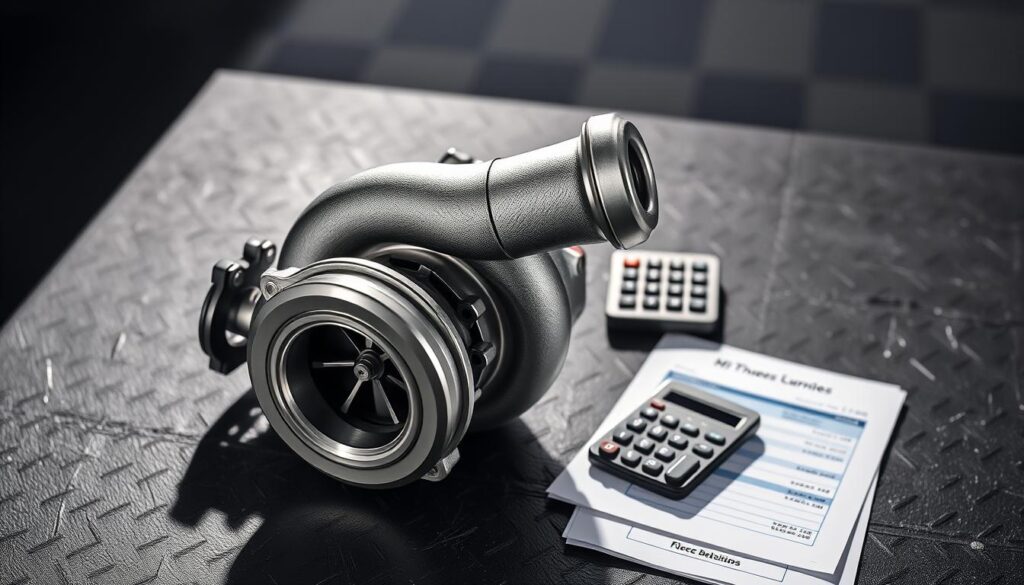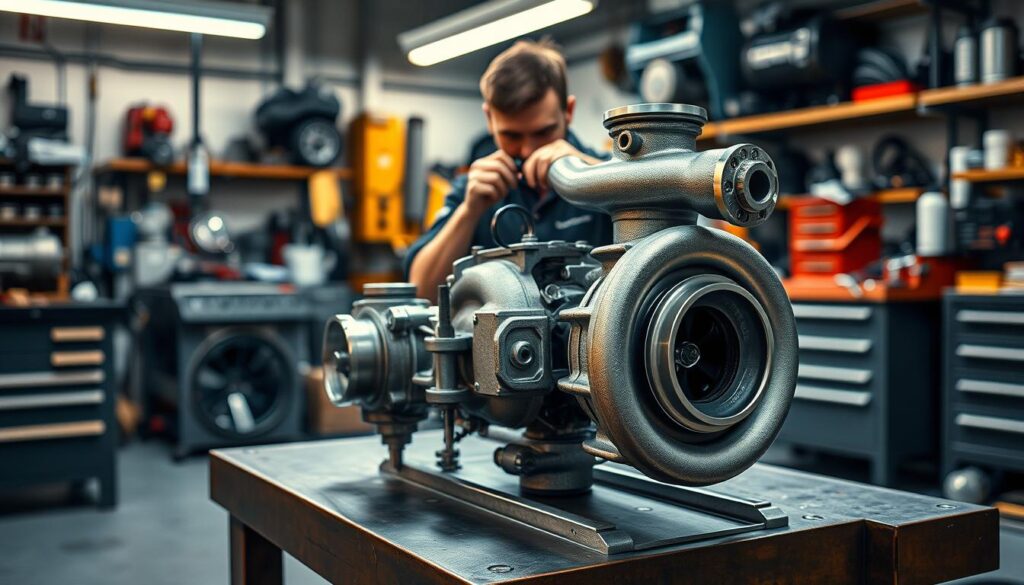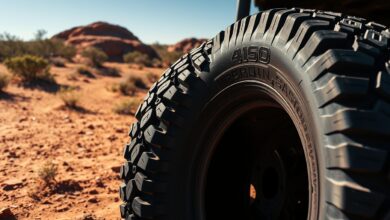Expert Tips on Selecting the Right 4×4 Turbocharger

Upgrading your 4WD’s turbocharger boosts power and performance. The right turbocharger can greatly improve your vehicle’s capabilities.
Selecting the right 4×4 turbocharger requires looking at your vehicle’s specs and driving habits. The right turbocharger can enhance your vehicle’s performance and efficiency.
Key Takeaways
- Understand your vehicle’s specifications before choosing a turbocharger.
- Consider your driving habits to determine the right turbocharger for your needs.
- A well-chosen turbocharger can significantly enhance your vehicle’s performance.
- Research different turbocharger options to find the best fit for your 4WD.
- Consult with a professional to ensure a proper installation.
Understanding Turbochargers and Their Benefits
A turbocharger is a big improvement for any car, boosting efficiency and power a lot. It works by compressing air, leading to better combustion and more power.
What is a Turbocharger?
A turbocharger, or turbo, is a device that uses exhaust gases to drive a turbine. This turbine powers a compressor to push more air into the engine. It makes the engine more efficient by letting it use more air.
How Turbochargers Enhance Performance
Turbochargers help engines perform better by letting them use more air. This means more power and torque, making the car quicker and more powerful. It also means the engine can run on less fuel, which can save money on gas.
Pros and Cons of Installing a Turbocharger
Getting a turbocharger can boost your car’s power and efficiency. But, it’s important to think about the downsides. These include higher costs, more complexity, and possible reliability problems if not done right.
| Pros | Cons |
|---|---|
| Increased Power Output | Higher Cost |
| Improved Engine Efficiency | Increased Complexity |
| Better Fuel Economy | Potential Reliability Issues |
Knowing the good and bad points is key to deciding if a turbocharger is good for your car. Think about how you drive, what kind of car you have, and the cost of upkeep.
Key Factors to Consider When Choosing a Turbocharger
Choosing the right turbocharger is all about knowing what your 4×4 needs. It’s important to look at several key factors. These factors affect how well your 4×4 performs and how efficient it is.
Size and Fitment for Your 4×4
The size of the turbocharger is very important. A turbo that’s too small won’t give you the boost you want. On the other hand, a turbo that’s too big can cause turbo lag and lower efficiency. To find the right size, you need to calculate the mass flow needed.
Key considerations for size and fitment include:
- Compressor wheel size and trim
- Turbine wheel size and trim
- A/R ratio of the turbine housing
Boost Levels and Performance Goals
Your goals for performance will help you choose the right turbocharger. If you want high boost levels, you need a turbo that can handle it. It’s important to balance boost levels with engine durability to avoid damage.
Factors to consider for boost levels and performance goals:
- Desired boost pressure
- Engine’s ability to handle increased pressure
- Supporting modifications (e.g., intercooler, fuel system upgrades)
Engine Compatibility and Type
Not every turbocharger fits every engine. The engine’s size, type (like diesel or petrol), and layout (like inline or V6) matter a lot. Making sure the turbo fits your engine is key for the best performance and to avoid engine damage.
Engine compatibility considerations:
- Engine displacement and type
- Cylinder head design and configuration
- Exhaust system compatibility
By carefully looking at these factors, you can pick a turbocharger that’s just right for your 4×4. This will boost its performance and efficiency.
Types of Turbochargers: Which One is Right for You?
For 4×4 fans, knowing about different turbochargers is key. Each type has its own benefits. Choosing the right one can really boost your vehicle’s performance.
Single vs. Twin Turbochargers
The choice between single and twin turbochargers depends on what you need. A single turbocharger is simpler and cheaper but might not be as powerful. Twin turbochargers, on the other hand, work better by using one turbo at low speeds and the other at high speeds. This cuts down on turbo lag and boosts power across the RPM range.
- Single Turbo: Simpler, less expensive, but potentially less powerful.
- Twin Turbo: More complex, offers better performance and reduced turbo lag.
Ball Bearing vs. Journal Bearing Turbos
Choosing between ball bearing and journal bearing turbos depends on what you value most. Ball bearing turbos have less friction and respond faster, making them great for high-performance needs. Journal bearing turbos are more common and cheaper but might have more friction and slower response times.
If you want the best performance, ball bearing turbos are the way to go. They’re more efficient and spool up faster.
Benefits of Variable Geometry Turbochargers
Variable Geometry Turbochargers (VGTs) are versatile because they adjust their turbine blades for better performance at different speeds. This tech improves fuel efficiency, cuts emissions, and makes the engine more responsive.
For more info on turbochargers and their uses, check out our detailed guide: Everything You Ever Wanted to Know About a.
Importance of Material and Build Quality
Choosing the right turbocharger for your 4×4 is all about material and build quality. These factors greatly affect how well it performs and lasts. Turbochargers face high temperatures and pressures, so the materials and how they’re built are key.
Comparing Aluminum and Cast Iron
The choice between aluminum and cast iron for turbochargers is a big debate. Aluminum is light and helps with heat, making the turbo work better and faster. Cast iron, on the other hand, is tough and can handle very high temperatures and pressures.
- Aluminum: Better at cooling and is lighter, making the turbo quicker.
- Cast Iron: More durable and can handle extreme heat and pressure.
The Role of Exhaust and Compressor Housing
The exhaust and compressor housing are vital parts of a turbocharger. They guide exhaust gases and compressed air. The material of these parts greatly influences the turbo’s performance and efficiency. A good compressor housing improves airflow, while a strong exhaust housing can handle high temperatures.
Durability and Heat Resistance
Durability and heat resistance are essential for a turbocharger. Top brands like GTurbo, Kinugawa, and CCT focus on using the best materials and engineering. This ensures their turbos are built to last.
When picking a turbocharger, look at the manufacturer’s attention to material quality and build durability. This impacts the turbo’s performance, longevity, and reliability. Opting for a high-quality turbocharger means a better driving experience and fewer maintenance costs in the long run.
Evaluating Your Driving Style and Needs
Figuring out your driving style and needs is key to finding the perfect turbocharger for your 4×4. You need to think about several factors that affect your vehicle’s performance and efficiency.
Off-Road vs. On-Road Performance
First, consider if you drive off-road or on paved roads. Off-road drivers face issues like turbo lag, which is a delay in power when you press the gas. For off-roading, a turbocharger that boosts power quickly and can handle tough terrain is vital.
“A good turbocharger can make all the difference in off-road performance, providing the power and responsiveness needed to tackle challenging trails,” says an expert in the field.
Driving off-road means your turbocharger must handle dust, debris, and extreme temperatures. On the other hand, on-road driving is smoother and puts less stress on the turbocharger.
Towing and Hauling Considerations
If you tow or haul heavy loads, you need a turbocharger that adds extra power and torque. Towing and hauling strain the engine, and a strong turbocharger helps manage this. Look for a turbocharger with high boost pressure and a sturdy compressor wheel.
For towing and hauling, a turbocharger that resists heat well is also important. Too much heat can reduce performance and shorten its life.
Daily Driving vs. Racing Applications
Your driving habits also affect the right turbocharger choice. For daily driving, a turbocharger that balances power and fuel efficiency is best. But if you race, you’ll need one that offers high boost pressures and quick spool-up times.
Racing requires advanced turbocharger features like variable geometry or ball-bearing technology. These help reduce turbo lag and boost performance.
Assessing Your Budget and Costs
Thinking about upgrading your 4×4’s turbocharger? It’s important to know the costs involved. The price isn’t just for the turbocharger itself. It also includes installation, any extra parts you might need, and future maintenance.

Price Ranges for Different Turbocharger Types
Turbocharger prices vary a lot. A basic one might start at $500, while top-of-the-line ones can be over $2,000. Top turbocharger recommendations for 4×4 vehicles usually fall in this range, depending on the model.
Looking for the best deal? Compare prices and consider things like compatibility, performance, and the brand’s reputation.
Installation Costs: DIY vs. Professional
Installation costs can add a lot to the total price. Labour can cost between $500 to $2,000, based on how complex the job is and the mechanic’s rates.
“A professional installation ensures that the turbocharger is fitted correctly, minimizing the risk of damage to your engine and ensuring optimal performance.”
Doing it yourself can save money, but you need to know a lot about mechanics and have the right tools. Many people prefer the peace of mind and warranty that come with a professional job, even if it costs more.
Long-Term Maintenance and Upgrades
There are ongoing costs with a turbocharged engine. Regular maintenance, like oil changes and filter replacements, is key to keeping the turbocharger running well.
- Regular oil changes to prevent oil starvation
- Filter replacements to ensure clean air intake
- Monitoring boost pressure to avoid excessive strain
Some people also upgrade parts like the intercooler or exhaust system to get even more out of their turbocharger. These upgrades can increase the cost but can also improve performance and efficiency.
By understanding all the costs involved, you can make a smart choice when picking a turbocharger for your 4×4.
Selecting the Right Brand and Model
The market has many turbocharger brands and models. Choosing the right one for your 4×4 needs careful thought. It’s important to look at several key factors when deciding.
Top Brands in the Market
Several well-known brands lead the turbocharger market. These include GTurbo, Kinugawa, and CCT. They offer a variety of turbochargers for different engine sizes and power needs.
GTurbo is famous for its high-performance turbochargers. They are great for both on-road and off-road use.
Manufacturer Reputation and Support
Choosing a turbocharger brand means looking at the manufacturer’s reputation and support. A brand with good customer support can greatly improve your experience. Look for brands known for reliable products and strong warranties.
Warranty and Guarantee Considerations
A good warranty gives you peace of mind when buying a turbocharger. Brands like Kinugawa and CCT have strong warranty programs. These cover defects and performance issues.
Understanding your warranty is key to making a good choice. This way, you get a turbocharger that meets your needs and offers long-term reliability and support.
The Importance of Proper Installation
To get the most out of your turbocharger, how you install it is key. It’s not just a simple swap; it involves the intake system, exhaust manifold, oil and coolant lines, and ECU tuning.
DIY Installation Tips and Tricks
If you’re doing it yourself, be detailed. Make sure all connections are tight and the turbocharger is right with the engine’s systems.
- Read the instructions carefully.
- Have all tools and parts ready before you start.
- Check all connections and fittings for leaks or misalignments.
Hiring a Professional Installer
Getting a pro to do it can save you time and ensure it’s done right. They know how to handle any problems that come up.
Benefits of professional installation include:
- Guaranteed quality work.
- Following the manufacturer’s specs.
- Keeping your warranty intact.
Ensuring Maximum Performance Post-Installation
After it’s installed, keep an eye on how it’s doing. Make changes if needed. Regular checks can spot problems early.
Key post-installation checks include:
- Watch the boost pressure.
- Look for oil leaks.
- Make sure ECU tuning is right for best performance.
By following these tips, your turbocharger will run at its best. This boosts your car’s power and efficiency.
Balancing Performance with Reliability
Getting a turbocharger to work right is all about finding the right balance. It boosts your 4×4’s power, but you must watch out for reliability problems. A good turbocharger can make your vehicle much better, but you need to avoid common mistakes.
Avoiding Common Turbo Installation Mistakes
Many people mess up their turbo installs because of small mistakes. These include wrong oil line setup, not priming the turbo, and using the wrong bolts. Not tuning the ECU and using low-quality parts are also big no-nos. To avoid these, follow a detailed installation guide.
- Make sure the oil lines are set up right to avoid leaks or oil starvation.
- Prime the turbo before starting the engine to prevent damage.
- Use the right amount of force when tightening bolts to avoid leaks or damage.
- Adjust the ECU to match the turbo’s needs for the best performance.
- Choose top-notch gaskets and seals to prevent leaks and ensure the parts last long.

Regular Maintenance Practices
Keeping your turbocharger in top shape is key. This means checking the oil often, looking for wear or damage, and making sure it’s well-lubricated.
Key maintenance tasks include:
- Change the oil regularly to keep the turbo well-lubricated.
- Look for signs of wear on the turbo and its parts.
- Check for leaks or damage on the oil lines and other parts.
Signs Your Turbocharger Needs Attention
Knowing when your turbocharger needs help can stop big problems. Look out for smoke from the exhaust, less power, strange noises, and more oil use than usual.
Common indicators of turbocharger issues:
- Smoke from the exhaust means oil might be leaking.
- Less power could mean the turbo is failing or has a boost problem.
- Unusual sounds like whining or grinding might mean it’s broken.
- More oil use than usual could mean leaks or oil burning.
By spotting these signs early and keeping up with maintenance, your turbocharger will run smoothly. This keeps your 4×4 performing well without losing reliability.
Understanding Turbocharger Accessories
To get the most out of your 4×4 turbocharger, knowing about accessories is key. These accessories boost performance, efficiency, and the driving feel.
Essential Upgrades for Optimal Performance
Choosing the right accessories for your turbocharger can really up your 4×4’s game. Some makers offer upgrade kits with extras like intercoolers and wastegates. These add-ons make your turbo setup even better for top-notch performance.
Here are some upgrades to think about:
- High-performance intercoolers to cut intake temps
- Adjustable wastegates for better boost control
- Blow-off valves to stop compressor surge
Intercoolers, Wastegates, and BOVs
Intercoolers cool the air from the turbocharger, making it denser and more powerful. Wastegates control the boost pressure, stopping the turbo from over-boosting. Blow-off valves (BOVs) let out extra pressure when the throttle is closed, protecting the turbocharger.
These accessories offer big benefits:
- More power from cooler, denser air
- Smarter boost pressure control
- Less chance of turbocharger damage
Importance of a Quality Exhaust System
A top-notch exhaust system is essential for your turbocharger’s best performance. It makes sure exhaust gases flow well, letting the turbocharger spin efficiently and provide the right boost pressure.
A well-made exhaust system boosts turbocharger response and engine performance. When picking an exhaust system, look at material, design, and if it fits your turbocharger and engine.
Knowing the Legal Implications
Upgrading to a turbocharger can make your 4×4 perform better. But, it’s key to know the legal side. Turbo upgrades can change your vehicle’s emissions, insurance, and if it’s legal.
Emissions and Regulations in Your State
Australia’s states have different rules on emissions. For example, New South Wales has strict rules on car mods. You must check with your local transport office to see if your turbo 4×4 meets emissions standards.
| State/Territory | Emissions Regulations | Compliance Requirements |
|---|---|---|
| New South Wales | Strict emissions controls | Certificate of Compliance required |
| Victoria | Regulated emissions standards | Inspection and certification needed |
| Queensland | Emissions testing for modified vehicles | Compliance testing required for registration |
Modifications and Insurance Considerations
Adding a turbocharger can change your insurance costs. Tell your insurance company about the upgrade to avoid problems later.
“Failing to disclose modifications can void your insurance policy. Always notify your insurer about any changes to your vehicle.” – Insurance Expert
Staying Compliant with Vehicle Upgrades
To stay legal, get your turbo upgrade from a trusted installer who knows the rules. Regular checks and upkeep can also prevent legal trouble.
Understanding and following the legal rules of turbo upgrades lets you enjoy the performance boost without legal worries.
Expert Recommendations and Final Thoughts
Choosing the right turbocharger for your 4×4 is key to better performance. Look at size, boost levels, and engine fit. Quality parts, correct install, and tuning are vital for top performance.
Key Considerations
For the best turbocharger results, balance performance with reliability. Steer clear of sizing errors, bad installs, and skipping maintenance. Proper tuning boosts your vehicle’s performance.
Engaging with the 4×4 Community
Talking to the 4×4 community offers great advice and insights. Share your experiences and learn from others. The community is a great place for turbocharger tips and advice.
FAQ
What are the key factors to consider when selecting a 4×4 turbocharger?
When picking a turbocharger, look at size, boost levels, and engine fit. Also, check the material quality for best performance and lasting durability.
How do I determine the right turbocharger size for my 4×4 vehicle?
To find the right turbo size, think about your engine’s size, desired boost, and performance goals. Talk to a turbo expert or follow the manufacturer’s advice.
What is the difference between single and twin turbochargers?
Single turbochargers use one turbine for air compression. Twin turbochargers use two, for quicker spooling and more power. But, they’re more complex and costly.
How do I know if a turbocharger is compatible with my engine?
Check the turbo’s specs, like compressor and turbine sizes. Also, talk to a mechanic or the manufacturer to make sure it fits your engine.
What are the benefits of variable geometry turbochargers?
Variable geometry turbochargers improve boost response and power output. They also boost fuel efficiency by adjusting the turbine angle for better performance across RPM ranges.
How important is material quality in a turbocharger?
Material quality is key for durability, heat resistance, and performance. High-quality materials like forged aluminum or cast iron can make the turbocharger more reliable and long-lasting.
What are the costs associated with turbocharger upgrades?
Upgrade costs vary by type, brand, and installation. Consider the turbocharger price, installation, and future maintenance and upgrade costs.
Do I need to hire a professional to install a turbocharger?
While you can install it yourself, it’s safer and better to hire a pro. They ensure proper installation, performance, and safety.
How do I maintain my turbocharger for optimal performance?
Keep it running well by monitoring boost pressure, checking for leaks, and doing regular oil changes. Avoid neglecting worn-out parts.
What are the legal implications of turbocharger upgrades?
Upgrades might affect emissions, insurance, and local laws. Always check and follow regulations to avoid fines or penalties.
Can I use a turbocharger designed for on-road use for off-road applications?
While it’s possible, an on-road turbo might not be best for off-road. Look for one designed for off-road, with higher boost and durability.
How do I choose the right brand and model of turbocharger?
Research well-known brands and their reputation. Look at warranties and support too. Choose a reliable turbo that fits your needs and budget.





